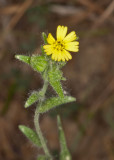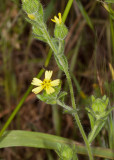Form and Function
Madia
gracilis is a native plant that is found throughout the Pacific
Northwest of the United States. It is commonly known as either
Slender or Grassy Tarweed (Ross 2012).
M. gracilis has some specific characteristics that set it apart from
many of the other plants in its surrounding area. The plant
itself grows anywhere from 4-40 inches in height, which can
assist this plant in collecting sunlight and attracting
pollinators (Ross 2012). Looking at
M. gracilis you will
notice that they have thin stems that are covered with many
hairs (Turner 2013). At the top of these stems you will notice
flowers that when bloomed release bright yellow petals that
make it daisy-like in appearance (Ross 2012).
Also,
M. gracilis has been
described as an aromatic plant, meaning it has a distinct smell
(Ross 2012). The smell given off by.
M. gracilis is
described as being strong and ill scented (Lowry 2009). 
One characteristic found in many
Madia species is the use
of glandular trichomes to help protect the plant from herbivores
(Krimmel and Pearse 2013). The glandular trichomes secrete a sticky substance
that covers the outside of
Madia species, when herbivore insects land on the plant
they get stuck (Krimmel and Pearse 2013). This
sticky substance explains why these species are considered Tarweeds.
Significant to many
Madia species is that they
are specifically adapted to grow in the dry, hot climates in the
summer of the Pacific Northwest (Strong and Chester 2000). These species sprout
in the spring, but do not flower till mid-late summer (Krimmel and
Pearse 2013),
this lateness has caused these plants to be known as “late bloomers”
(Strong and Chester 2000). Because Madia
species bloom late, most of the other flowers of the have already
bloomed and dried up under the summer heat. With most other plants
already bloomed and dried up
Madia species have little competition for pollinators, water,
and other soil nutrients (Strong and Chester 2000).
The sticky substance that
covers Madia species is also helpful with the prevention of water
loss (Strong and Chester 2000), similar to the cuticle that is found on
Hepatophyta.
 The
majority of the nutrients gained are taken up through the root
structures. Madia gracilis has a mixture of a developed tap
root and a complex system of fine root hairs (Antos and Halpern
1997). Because of this mixture, the plant is able to absorb all of
the nutrients close to the earth’s surface, as well as shooting down
enough to absorb water from deep down in the typically sandy soil.
This shallow, widespread root system also explains other
characteristics of the M. gracilis. Shallow root systems
allow for rapid uptake of water and minerals that are close to the
earth’s surface. Many of the regions that the M. gracilis
lives in are prone to drought in the later parts of the summer, so
this root system allows for the plant to absorb as much water as it
can in the early part of the growing season so the seeds can be
produced before the plant is exposed to unlivable conditions (Antos
and Halpern 1997).
The
majority of the nutrients gained are taken up through the root
structures. Madia gracilis has a mixture of a developed tap
root and a complex system of fine root hairs (Antos and Halpern
1997). Because of this mixture, the plant is able to absorb all of
the nutrients close to the earth’s surface, as well as shooting down
enough to absorb water from deep down in the typically sandy soil.
This shallow, widespread root system also explains other
characteristics of the M. gracilis. Shallow root systems
allow for rapid uptake of water and minerals that are close to the
earth’s surface. Many of the regions that the M. gracilis
lives in are prone to drought in the later parts of the summer, so
this root system allows for the plant to absorb as much water as it
can in the early part of the growing season so the seeds can be
produced before the plant is exposed to unlivable conditions (Antos
and Halpern 1997).
Go Home, or continue on to Life Cycle.
